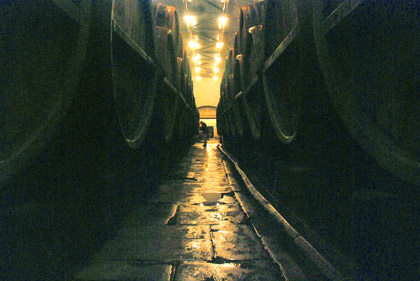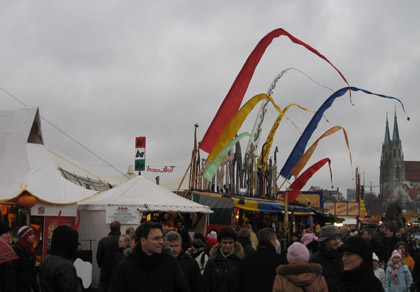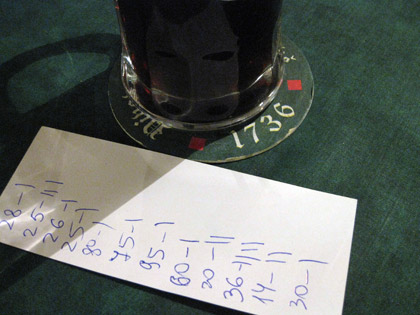We were forewarned by Ron Pattinson (read the comments too) not to expect too much from the Pilsner Urquell brewery tour. However, rather than requesting a behind-the-scenes look during which I could ask my usual geeky questions, I wanted to see and hear how the brewing giant SABMiller presents Urquell to the public.
I’m glad we went.
It was worth it if only to wander through the lagering cellars and imagine what they were like when they were full of more than the few barrels that remain.

Back to the beginning. The tour costs 150 Czech Koruna (less than $7.50), 100 more if you want to take pictures inside the factory (that’s what they call it). You’d think somebody there read Ron’s post, because they carefully warned us that the tour takes about 90 minutes and we might want to use the toilet before embarking.
In fact, it lasted 80 minutes (perhaps because there were only 11 of us, including four Czechs taking the English tour for reasons unknown) and didn’t start with a movie. We saw one movie as part of the introduction to ingredients, and it did a pretty good job of talking about stuff like triple decoction without using the word. We saw a second short movie taken at the brewery in the early 1900s.
As at Budejovicky Budvar a couple of days before we breezed past cyclindro-conical tanks and primary fermentation was mentioned only in passing, but unlike at Budvar we never saw actual lagering tanks — just the wooden ones where beer is aged for tourists to taste (the literature we received also indicated this beer is compared with the brewery’s industrially produced beer). Of course we wandered about the old shiny copper brewhouse, but could view the new one only through glass.
What made the tour worth it was the walk in the cellars. The tour guide emphasized many times to stick with the group so nobody would get lost. It was easy to imagine when the cellars were full of barrels. When we finally get back home I’m looking forward to watching Michael Jackson’s Beer Hunter video from the 1980s. Not only to compare what it looks like, but for answers to some of the questions Ron raised, like if lagering has been shortened over the years.
We stopped briefly at wooden open fermenters where the “tasting” beer undergoes primary fermentation. While I was taking pictures the tour moved on to the halls with lagering barrels, for what the guide called “the best part of the tour, tasting.” Now behind, I hurried through the first set of barrels, passing a man carrying a clipboard.
I stopped to take a picture of the barrels, dang hard to get them in the low light since I was determined not to use the flash. When I turned around I saw the man (a brewer?) at the other end drawing a sample. That’s the picture above.
By now Sierra was worried I was lost and she came back to drag me into the next room with barrels, where everybody was already drinking. A friendly fellow poured a sample into a small (100-200cl) glass. This was beer made in the old way, using open fermentation in wood and then lagered in the cellars in wood. It was not filtered. It was very good.
Nobody was talking, and by the time I tried to take a couple more photos and had enjoyed less than half the glass the tour was ready to move on. The guide said anybody was welcome to a second beer. Nobody took him up on it. Except me. I hurried back to the fellow pouring beer, handing him an empty glass while I finished the first (resisting chugging).
He smiled, poured one and seemed to suggest I could take one for each hand.
I declined.
Why I don’t know.

 Shawn and Nico have asked us to
Shawn and Nico have asked us to 
